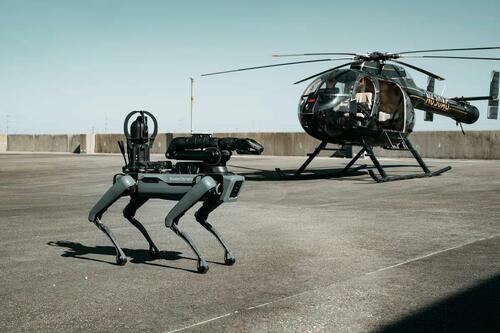See Spot Terminate: Police Increase Use Of Robot Dogs For Law Enforcement
Five years after Boston Dynamics introduced the cute but creepy “Spot” robot dog, the 5-pound German Shepherd-sized robot dog is finding work.
With its ability to climb stairs, open doors, and dazzle inebriated suspects, police are now using it in situations including armed standoffs, hostage rescues, and hazardous materials incidents – things where sending in a human or a real dog could be life-threatening.
According to Bloomberg, over 60 bomb squads and SWAT teams in the US and Canada are now using Spot, Boston Dynamics has revealed.
Yet, there are obvious ethical concerns – including oversight, and the risks that military-grade tools will be deployed in civilian settings.
Defense and public safety agencies are increasingly adopting cutting-edge technologies to enhance their operations. Defense tech funding has soared past $28 billion in 2025 — up 200% year over year, even as broader venture markets cooled, according to PitchBook data.
Robots in particular have been finding a home among law enforcement agencies. ICE, or US Immigration and Customs Enforcement, recently spent around $78,000 on a robot from Canadian tech manufacturer Icor Technology Inc. that can perform similar tasks as Spot and also deploys smoke bombs, according to contract records. -Bloomberg
That said, Spot has done good good-boy work; in 2022, it approached a man who had crashed his car while kidnapping his son in St. Petersburg, FL to see if the man was armed.
In Massachusetts last year, Spot helped assess a chemical waste accident at a North Andover Middle School, and intervened in a hostage situation in which a suspect had his mother at knifepoint and fired at officers. After spot cornered the man, police followed with tear gas to apprehend him.
“It did its job,” trooper and Massachusetts State Police bomb squad member John Ragosa told Bloomberg.”The suspect was stunned, thinking ‘What is this dog?’”
Spot starts at around $100,000, and in many cases can operate autonomously – performing maintenance checks, detecting gas leaks and inspecting faulty equipment. For now, it still relies on human operators like Ragosa for decision making – as an operator guides the ‘dog’ from a tablet while monitoring a live video feed from its onboard camera system. Spot’s built-in sensors handle things like navigation and mapping, as its technology continues to evolve.

Roughly 2,000 Spot units are operating globally, Boston Dynamics said – including within organizations such as the Dutch Ministry of Defense and Italy’s national police. While most customers are industrial clients – such as manufacturers and utility providers – law enforcement interest has ballooned over the past two years.
The Massachusetts State Police currently owns two Spot robots — one purchased in 2020 and another in 2022 — each costing about $250,000, including add-ons, and funded primarily through state grants, Ragosa said. He said he hopes the agency will add a third unit soon. Some other major cities also have fleets: Houston operates three Spots, while Las Vegas has one, Boston Dynamics said.
Not all departments are equipped to own advanced robots, Murphy said, adding that the question is whether the high cost and complexity of legged robots are worth the extra mobility they provide. -Bloomberg
(Eh… so $500,000 in taxpayer-funded robots in Massachusetts? Seems like a good candidate for #WasteOfTheDay…)
Meanwhile, civil liberties groups have expressed grave concerns over the use of semi-autonomous robots in law enforcement, which they say could normalize a more militarized approach to policing. In 2021, the NYPD suspended its limited use of Spot following public backlash – with critics.. criticizing both the cost and the surveillance aspect. The NYPD later reinstated the program and bought two of the robots, Boston Dynamics says.
“ou can’t really rely on the goodwill of a particular company when it comes to almost any of these technologies,” said Beryl Lipton, senior investigative researcher at the Electronic Frontier Foundation, or EFF. “It doesn’t matter who makes the gun — in general, there are rules about how guns get to be used.”
Lipton thinks there should be state and federal laws that provide basic guidance on when it’s appropriate to use the dogs, and expressed concern that the use of robot dogs within law enforcement puts a friendly spin on technology that can be used for policing.
“One of the things about the so-called robot dogs that we are a little wary of is this normalization and this sort of affectionate framing of calling it a dog,” she said. “It’s normalizing that for the public when it’s not actually a dog. It’s another piece of police technology.”
Ryan Calo, a professor at the University of Washington School of Law focusing on robotics law said “The unease people feel around robotics is not just a psychological quirk,” adding “They are disconcerting for a reason. The overuse of robotics in policing will further dehumanize police to the public and break down those community ties that have been so important to policing over so many years.”
Indeed, the uncanny valley intensifies…
So, to all the police dogs out there reading this right now, we’re sorry for your impending job loss.
Begun the robot dog war has?
h/t Capital.news
Tyler Durden
Thu, 11/20/2025 – 16:40ZeroHedge NewsRead More





 T1
T1



